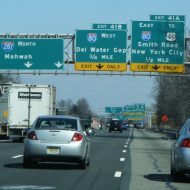Acid House is one of the first types of electronic music I listened to, and exposed me to a lot of the music that was coming out of England in the early to mid-90s. Acid House’s popularity may have revealed a distinct youth/party culture ready for new music, and new drugs, or the experience itself created many new converts in the UK and started rave culture altogether. Either way, Acid House was what people in the UK listened to in the late 80s during the “Second Summer of Love”, a high point in the permeation of the counterculture, and a critical time in the development of electronic music.
While listeners of Acid House did use drugs when dancing to the music, mostly LSD and Ecstasy, Acid House is not distinguished by its audience’s hallucinogenic use as most of the people dancing to House music at the time were on drugs. But the music’s odd sounds, particularly from the Roland TB-303 bass synthesizer, characterize the music and make it sound a little psychedelic when paired with studio effects. Simply put, the TB-303 is the Acid House sound.
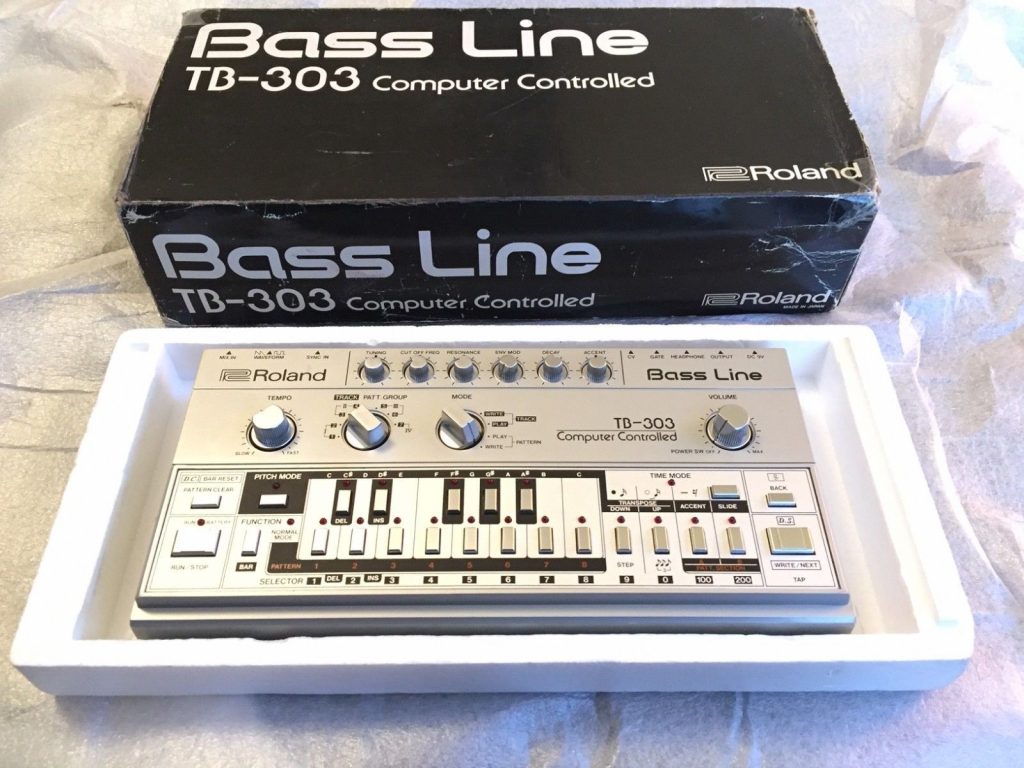
Musically Acid House is a variant of Chicago House sound that emerged after disco, but dropped most of the good feelings and heavily employed the TB-303 and its resonant filter. The TB-303 was released in 1982 and intended to accompany guitar players during practice, and for this purpose it was a failure and discontinued two years later. However, it did show up in some songs like Shannon’s Let the Music Play from 1984, and Charanjit Singh’s Synthesizing: Ten Ragas to a Disco Beat from 1982, which is the exact template for the Acid House sound. These songs were created years before this sound became popular in Chicago, and were inspired much more by the Roland drum machines and synthesizers used than any copious psychedelic drug use.
Chicago
Venues like the Warehouse, designed to recreate a spiritual experience and frequented by the gay Black and Latino population of Chicago, became very popular in the city. Acid House first became popular as a variant of the Chicago House sound played in the nightclubs there, particularly the Music Box, opened in 1982 by the eponymous Warehouse’s owners after Frankie Knuckles left. There is enough story there to fill a book, but for the purposes of this blog post was a major club catering to the House music audience in one of the House capitals of the U.S., if not the House capital, and Acid House is just one of the styles of House that arose out of Chicago.
As House music caught on it became more diverse, moving beyond its disco foundations and into deeper electronic territory and exploring darker sounds with a sinister mood uncharacteristic of popular House music. The “first” Acid House song is either Phuture’s Acid Tracks or Sleezy D’s I’ve Lost Control, both helping to define the genre by utilizing the TB-303 and TR-808 drum machine to produce a groove. Both songs feature the contributions of Marshall Jefferson, an integral part of the larger development of House music, and were introduced to the dancers of the Music Box by DJ Ron Hardy. Phuture’s Acid Tracks received its title after the song became so associated with Hardy that it was known as “Ron Hardy’s Acid Track”, who reportedly played it four times in one night to a confused but gradually more receptive audience, and it became a hit.
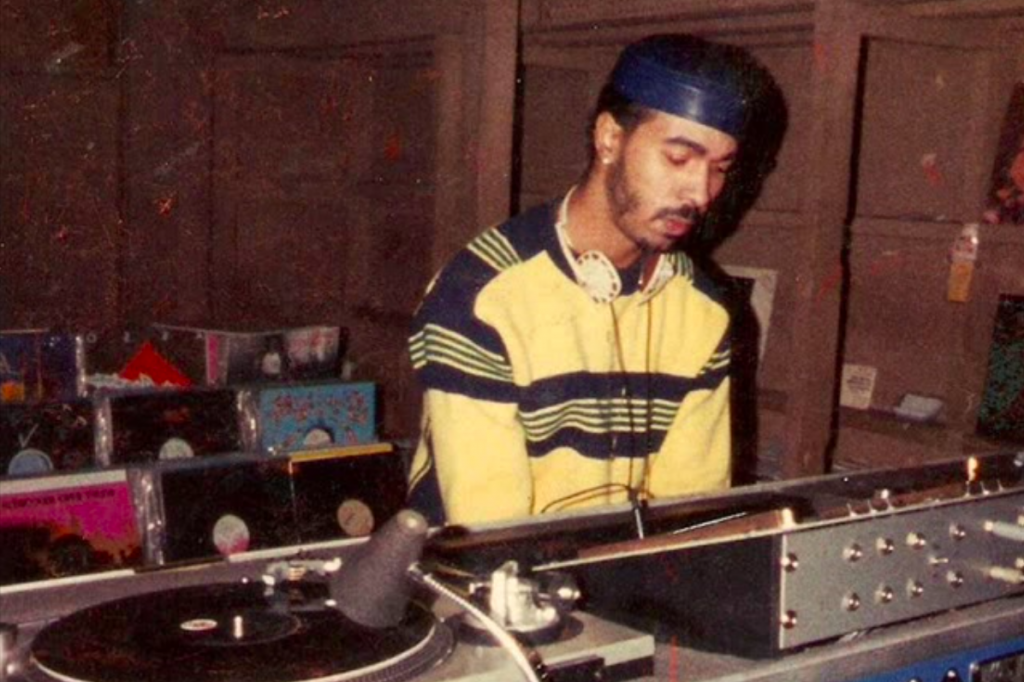
The use of ecstasy (MDMA) and LSD was common at the clubs, and a law passed in 1987 forbid clubs from operating after hours, which led to the closing of the Music Box, among others, driving the music underground. The House scene and its many subgenres in Chicago would eventually move on and inspire musicians in every country, and one genre, Acid House, would particularly resonate in the UK and grow to a wider audience.
Phuture – Acid Tracks (1987)
One of the early foundational acid house tracks, and possibly the first one. Phuture was composed of Chicago artists DJ Pierre, Earl “DJ Spank Spank” Smith Jr. and Herbert Jackson and produced by Marshall Jefferson. Acid Tracks is one of the first songs to feature the “squelchy” sounds of a resonant TB-303 bass and was a big hit in Chicago, inspiring every one of the Acid House records that followed.
Fast Eddie – Acid Thunder (1988)
A great example of the later Acid House tracks that Chicago was putting out, though the genre began to stall in the U.S. Fast Eddie had success as one of the creators of “hip house” and later failed to repeat it as a gangsta rapper, but his Acid Thunder is a typical Acid House song and exists in many mixes, such as the “Smooth Thunder” album mix with strings and diva vocals.
Sleezy D – I’ve Lost Control (1986)
The first time I heard this song I laughed at the level of anguish it expresses, including a man screaming in pain, turning to laughter. The lyrical repetition of “I’ve lost control” and “I’m losing it” along with a TR-808 drum pattern is pretty hypnotic, and the “Space side” of the track features the TB-303. Created by Marshall Jefferson and Derrick Harris, I’ve Lost Control was made to sound like a nervous breakdown and was recorded by the two after a night of clubbing and a probable bad trip inspired this classic. In my opinion, the House side is better.
Mr. Fingers – Washing Machine (1986)
Larry Heard recorded Washing Machine along with Can You Feel It in 1986 after buying a Roland TR-909 and Juno 60 and recording some of the enduring House tracks of the 80s. Heard drummed in progressive jazz fusion bands in the 80s before becoming successful with his Mr. Fingers alias and is largely credited with creating some of the first Deep House tracks. But Washing Machine is characteristic of the burgeoning Acid House sound that was growing more popular among the electronic musicians in the city.
DJ Maurice – This Is Acid (1988)
Originally produced by Chicago DJ Maurice Joshua, This Is Acid was remixed by British DJ Les Adams, who added sirens, female moans and a subtitle (A New Dance Craze) to reach No. 1 on the Billboard Hot Dance charts in 1989. Also features the stabs from Inner City’s Big Fun.
Adonis – No Way Back (1986)
Another classic Acid House track, Adonis Smith’s No Way Back is again comprised of the sounds of a TR-808 and TB-303. The subject material is also dark, with the vocals repeating “Too far gone” and “no way back”. Adonis worked on a number of other tracks and is considered a pioneer of the acid house sound.
Charanjit Singh – Raga Bhairav (1982)
Bollywood composer and electronic music visionary Charanjit Singh’s 1982 album Synthesizing: Ten Ragas To A Disco Beat features the TB-303, Roland TR-808 drum machine and a Roland Jupiter-8 to reproduce some classic Indian Ragas completely electronically. Truly amazing.
The UK
Acid House is said to have been born in the UK following a 1987 trip to Ibiza by DJs Danny Rampling, Nicky Holloway and Paul Oakenfold, where they took Ecstasy at the club Amnesia. According to Rampling, the experience was “a complete revelation” that led to their opening or running some of the most popular clubs in London in the late 80’s: Shoom (Rampling), Future (Oakenfold) and Trip (Holloway). The Hacienda, taking its name from the writings of Situationist philosopher Ivan Shcheglov, also opened in Manchester and helped break the music into the mainstream. An appreciation for Acid House and MDMA was cultivated in clubs throughout the UK and the same formula would continue to gain more and more adherents.
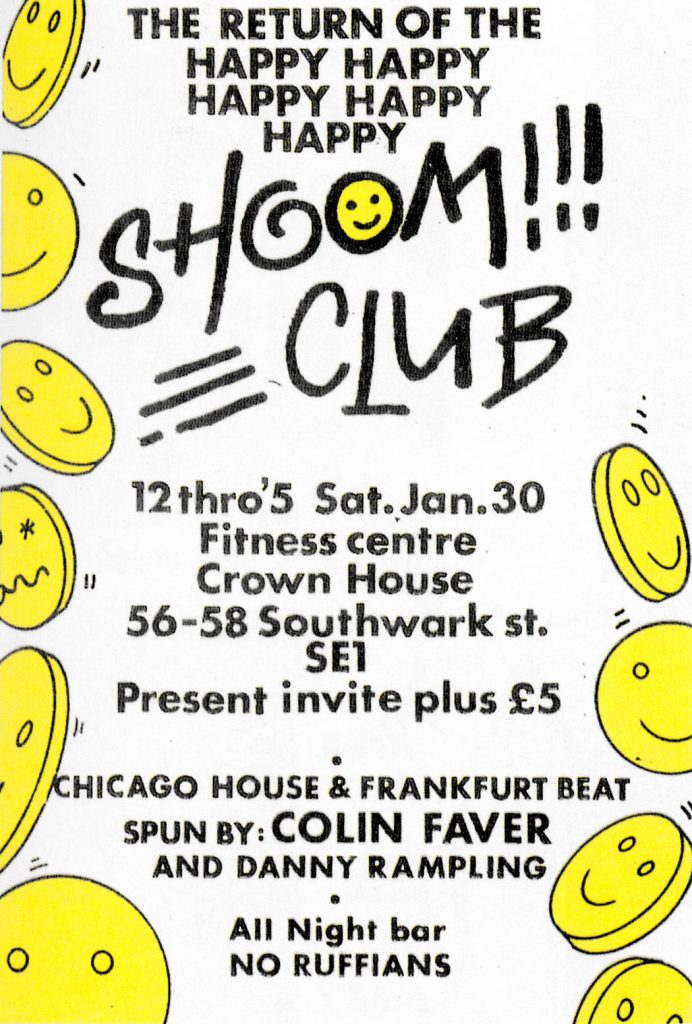
Dance clubs and appreciation of Black music from the U.S. had grown in the UK for decades, and along with historical engagement in fads like the mod scene, punk rock and 2-tone, the groundwork was laid for a cultural movement to spread across Great Britain. Additionally, a decade of Thatcherism and the Conservative government had created an environment ripe for counterculture, and combined with the pacifying effects of Ecstasy a repeatable and easily produced phenomenon was created.
Initially, UK Acid House borrowed heavily from the Chicago Acid House sounds, and the audiences mostly heard the same records pressed onto vinyl in Chicago. However, musicians started to produce their own music in the same style, and one of the groups to produce Britain’s first Acid House records were 808 State. Composed of Graham Massey, Gerald Simpson and Martin Price, 808 State combined the same Roland drum machine and synthesizer sounds with digital samplers to carry the sound into new territory. With their studio album Newbuild in 1988, the group released an early example of the music in LP format and influenced electronic music producers all over the country.
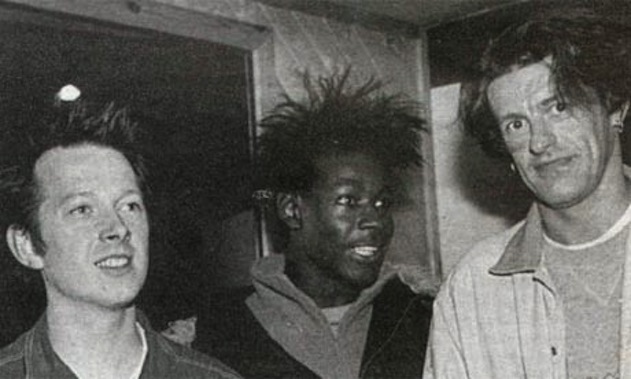
The early nights of Acid House began drawing larger crowds as the scene became more popular, and eventually outgrew the London clubs. The period of 1988-1989 is commonly termed the “Second Summer of Love” as partiers would flock to the suburbs and countryside of London, where promoters held unlicensed parties in abandoned warehouses or vacant farms, by the thousands. The drugs and music produced a euphoric response among the dancers, and is often credited with drastically reducing football hooliganism with positive feelings and empathy among people amplified by the experience.
The music also began reaching mainstream audiences, with artists like S’Express and Brian Dougans of Stakker Humanoid appearing on Top of the Pops. Laura Snapes, Deputy Music Editor of The Guardian, writes:
To watch Top of the Pops as 1987 gives way to 1988 is to watch the freaks taking over the asylum: after MARRS and Bomb the Bass’s earlier acid house hits, S-Express’s sample-heavy track affirmed the sound’s chart coronation, making the Stock Aitken Waterman stable look even more square, and stuck one in the eye of London’s throttlingly cool club scene with its euphoric, queer collage.
https://www.theguardian.com/music/2020/apr/27/the-100-greatest-uk-no-1s
The size, noise and drug use of the parties began inspiring a moral panic in the late 80s, and the tabloids of the time represented the music scene as dangerous and wicked.
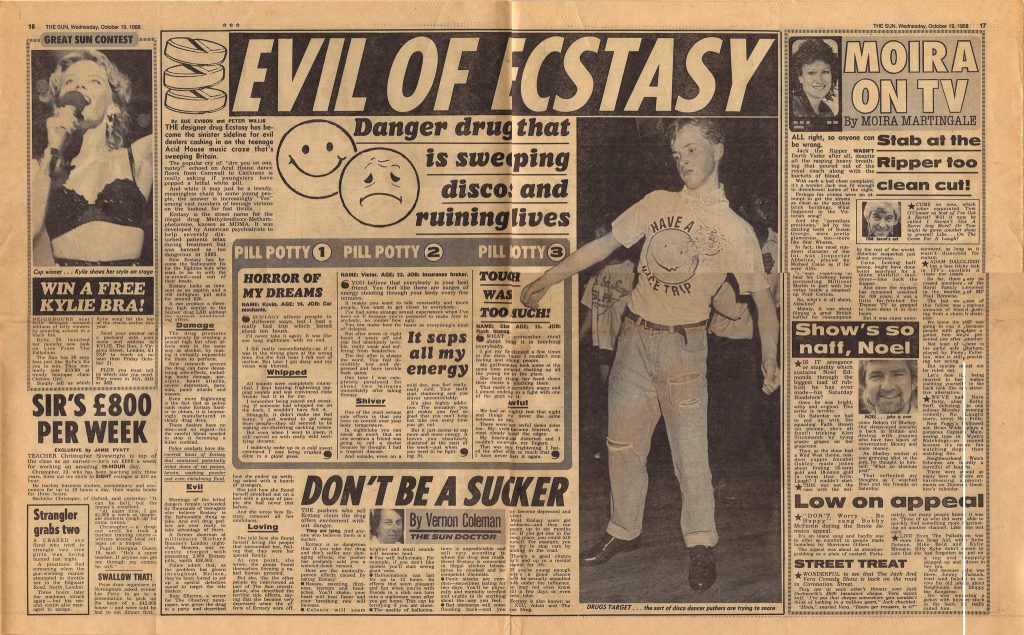
The government responded with the Entertainments (Increased Penalties) Act of 1990, which aimed to punish the organizers of parties and only served to drive the music further underground. The youth responded by adopting less surveillable methods of communication, typically systems of recorded messages directing crowds to locations far from London and the authorities. Eventually, the Rave scene would spring up as a result of Acid House’s growth and repression by the authorities.
A Guy Called Gerald – Voodoo Ray (1988)
In 1989 Gerald Simpson left 808 State and went solo and produced possibly the definitive UK Acid House track. Growing up in Manchester, Simpson was inspired by a lot of the early hip-hop/electro coming from the U.S. like Afrika Bambaataa along with music from his Jamaican background and the sound systems of the city. Voodoo Ray is often considered the template for the UK Acid House sound, mostly because of its enormous success, reaching No. 12 on the UK singles charts. A fun fact about the song is the title comes from the sampled vocal heard throughout, truncated by memory limitations from its original full “Voodoo Rage” to “Voodoo Ray”.
M|A|R|R|S – Pump Up the Volume (1987)
One of the first Acid House songs, Pump Up The Volume was the product of a collaboration between 4AD label mates Colourbox and A.R. Kane in 1987. Taking a sample from Eric B. and Rakim’s I Know You Got Soul, the song was an attempt to reach an audience piqued by American house imports and became a massive hit worldwide. The song was so popular it survived an attempt by Stock-Aitken-Waterman to block the song on the basis of an uncleared sample and it being a thorough rebuke to the stale trash they were producing at that point *groan*
808 State – Pacific State (1989)
A classic tune from 808 State, the song was created by the original trio of Massey, Simpson and Price and released after Simpson left the group. The dispute over ownership of the song continued long afterward, with Simpson claiming he wrote some or all of the song. It remains a great track and sounds fresh today, and there are about a thousand different versions of it following its release in 1989 on the Quadrastate EP. Pacific State also features a sample of a Canadian loon that subsequently become very popular in dance music.
Stakker – Stakker Humanoid (1988)
Created in 1988 by Brian Dougans, later of Future Sound of London fame. Stakker Humanoid was a favorite of the clubs in the UK at the time and even reached #17 on the top 40 charts, leading to an appearance on Top of the Pops by Dougans. In this clip, you can see the show basically just turn into an imitation of a club, though the audience is very much into it. This was the early stages of the Second Summer of Love, Dec. 1 1988 and shows the energy around the music at the time.
S’Express – Theme from S’Express (1988)
A classic of the UK Acid House scene, Theme from S’Express features the trademark TB-303 sound but you can also hear the beginnings of the Rave sound in the overt use of samples and collage. DJ and producer Mark Moore created the song with collaborator Pascal Gabriel, reaching No. 1 in the UK in April 1988, and 91 on the Billboard singles chart in the U.S.
Additional Materials
Grand Theft Auto: San Andreas – SF-UR (2004)
The soundtracks have always been a critical part of the Grand Theft Auto videogames, and SF-UR is a station from the 2004 game that features a lot of the music in this post. A well curated playlist of house and Acid House sounds from both sides of the Atlantic, better than one I could have come up with.
The Chemical Generation – A Channel 4 documentary produced in 2000 that examines the British dance movements of the 80s and 90s, featuring Boy George.
